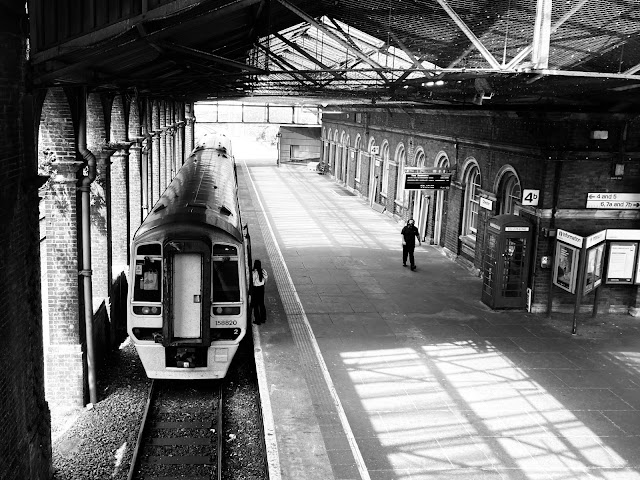On the rails: Caer in mono…
Rails that run through our lives like ribbons through time, echoed in the cathedrals of travel where travellers pause, contemplating which direction life will take them…
This small series of ‘mono’ shots taken at Chester last week were a study in something of the lost (at least in popular Railway media) art of the black and white photo. Not just desaturated colour but conceived with high contrast in mind.
My good friend Chris reflected earlier in the week that today’s digital is no match for the primeval light activated minerals of traditional film but rather than worry about the difference and shortcomings I tried to consider where the fundamentals of strong sunlight and it’ sharp shadows combine to produce striking results.
Reflecting back on these compositions the first pair, with their hint of humanity feel alive, whereas the latter two, born of architectural composition feel cold, almost dead. The human element that for years I’d attempt to crop out of my photography, my models even, has the power to take a poor imitation of a lost craft into something approaching art, and the moments wandering the familiar welcoming well worn routes around Chester station feel like an investment in heart and soul.
Until next time, more soon…
Donate
I love writing and creating material for the blog. If you enjoy what you read and engage with I would be appreciative of any donation, large or small, to help me keep it advert and restriction free.




I have a dedicated b&w digital camera that I use most of the time . I find it alters how I take photos. It becomes a much more thoughtful process at one level, whilst at another you develop (sorry) an instinct for what will and won't work in mono.
ReplyDeleteThat’s interesting James, one thing I can’t easily replicate without photoshop is grain.
DeleteObviously even mine can't truly emulate grain, but because it lacks a colour sensor the noise is grain like, though itonly cuts in at VERY high ISO numbers. You can tools that do a good job of emulating film, like DxO Filmpack, or even Snapseed on the phone.
DeleteIndeed, b/w images can impart a whole new atmosphere to a scene. On another note, that top image gives another possible interpretation of the "End of the Line" concept outlined in your book.
ReplyDeleteThank you Ian. And yes, perhaps, and in this instance giving two exits (under my feet too…)
Delete